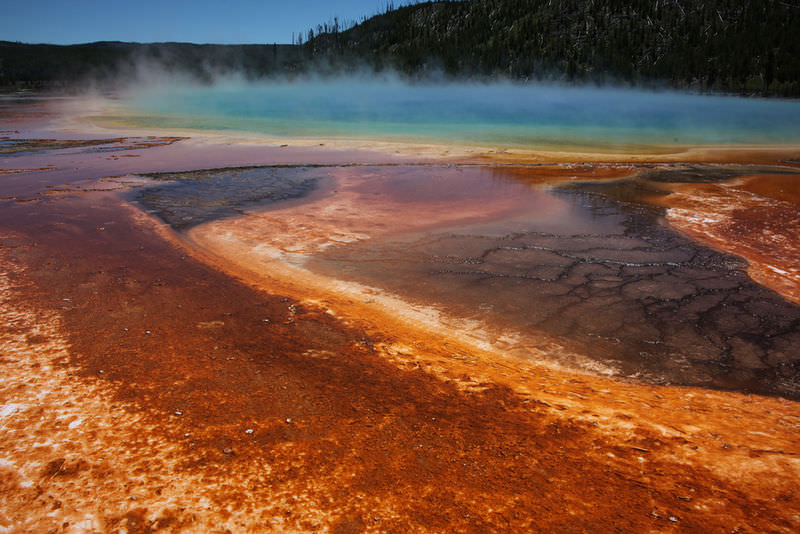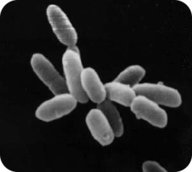5.6 Archaea
章节大纲
-
What organisms can grow in the hot springs of Yellowstone National Park?
::在黄石公园的温泉里能生长出什么生物?In the 1970s, a new group of organisms was identified. Unlike other organisms, these organisms could thrive in temperatures near 100ºC, the boiling point of water! This new group of organisms was named archaea.
::1970年代,发现了一个新的生物群。 与其他生物体不同,这些生物体可以在温度接近100摄氏度(水沸点)的温度下生长!这组新的生物体被命名为考古。What are Archaea?
::阿尔凯亚是什么?For many years, archaea were classified as bacteria . Like the bacteria, archaea lacked a and membrane-bound and, therefore, were prokaryotic cells . However, when scientists compared the of the two prokaryotes , they found that there were distinct differences. They concluded that there must be two distinct types of prokaryotes, which they named archaea and bacteria.
::多年来,古代被归类为细菌,像细菌一样,古代缺乏一种和膜,因此是血清细胞。然而,当科学家比较了两种直肠细胞时,他们发现存在明显差异。他们的结论是,必须有两种不同的直肠和细菌,它们称为直肠和细菌。Even though the two groups might seem similar, archaea have many features that distinguish them from bacteria:
::尽管这两类人可能看起来相似,但古代有许多特征,将它们与细菌区别开来:-
The
cell walls
of archaea are distinct from those of bacteria. While bacteria have cell walls made up of the polymer
peptidoglycan
, most archaea do not have peptidoglycan in their cell walls.
::虽然细菌的细胞壁由聚合物百头蛇管组成,但大多数考古学家的细胞墙中没有百头蛇管。 -
The plasma membranes of the archaea are also made up of
lipids
that are distinct from those in bacteria.
::古代的等离子膜也由不同于细菌的脂质组成。 -
The ribosomal
proteins
of the archaea are similar to those in
eukaryotic cells
, not those in bacteria.
::古代的血清蛋白质 与古代细胞的血清蛋白类似 而不是细菌的蛋白蛋白
Although archaea and bacteria share some fundamental differences, they are still similar in many ways:
::虽然古老和细菌有着一些基本差异,但它们在许多方面仍然相似:-
They both are single-celled, microscopic organisms that can come in a variety of shapes (
Figure
).
::它们都是单细胞微生物,可以以多种形状出现(图)。 -
Both archaea and bacteria have a single circular
chromosome
of DNA and lack membrane-bound organelles.
::考古和细菌都有单一的DNA圆形染色体,并且缺乏含有膜的有机体。 -
Like bacteria, archaea can have
flagella
to assist with movement.
::像细菌一样,考古可以有 国旗协助移动。
Archaea shapes can vary widely, but some are bacilli (rod-shaped).
::Archaea形状可能大不相同,但有些是bacilli(正形)。Obtaining Food and Energy
::获得粮食和能源Most archaea are chemotrophs and derive their energy and nutrients from breaking down molecules in their environment. A few species of archaea are photosynthetic and capture the energy of sunlight. Unlike bacteria, which can be parasites and are known to cause a variety of diseases, there are no known archaea that act as parasites. Some archaea do live within other organisms. But these archea form mutualistic relationships with their host , where both the archaea and the host benefit. In other words, they assist the host in some way, for example by helping to digest food.
::多数古老的古代是化学化学,其能量和养分来自其环境中的分裂分子。少数几类古代是光合和捕捉阳光的能量。与细菌不同,细菌可以是寄生虫,已知可造成多种疾病,没有已知的古代可以作为寄生虫。有些古代的确生活在其他生物中。但这些古代与宿主形成了相互的关系,既包括古代,也包括宿主的利益。换句话说,它们以某种方式帮助宿主,例如帮助消化食物。Reproduction
::复制复制Like bacteria, in archaea is asexual. Archaea can reproduce through binary fission , where a parent cell divides into two genetically identical daughter cells . Archaea can also reproduce asexually through budding and fragmentation , where pieces of the cell break off and form a new cell, also producing genetically identical organisms.
::像细菌一样,在古代中,古代是非性。 Archaea可以通过二进制裂变繁殖,在二进制裂变中,母细胞分裂成两个基因相同的女儿细胞。 Archaea也可以通过胚胎和破碎而性繁殖,细胞碎片断裂并形成一个新的细胞,同时产生基因相同的生物体。Further Reading
::继续阅读Summary
::摘要-
Archaea are prokaryotes, but they differ from bacteria in their DNA and biochemistry.
::Archaea是原虫, 但它们在DNA和生物化学中与细菌不同。 -
Most archaea are chemotrophs, but some are photosynthetic or form mutualistic relationships.
::多数古代是化肥类,但有些是光合或形成相互关系。 -
Archaea reproduce asexually through binary fission, fragmentation, or budding.
::Archaea通过二进制裂变、破碎或萌芽,性繁殖。
Explore More
::探索更多Use the resource below to answer the questions that follow.
::利用以下资源回答以下问题。-
Introduction to the Archaea
at
.
::Archaea Achaea的介绍
-
What are the three domains of life?
::生活的三个领域是什么? -
Why was the name Archaeabacteria misleading?
::为什么Archaeabaceria这个名字会误导人? -
What is bacteriorhodopsin? What is the role of bacteriorhodopsin in ATP production?
::什么是细菌多普辛?细菌多普辛在ATP生产中的作用是什么?
Review
::回顾-
Describe two ways archaea are different from bacteria?
::描述老古董和细菌有两种不同吗? -
How can archaea reproduction be distinct from bacterial reproduction?
::古代生殖与细菌生殖有何区别? -
How do most archaea obtain energy?
::大多数考古学家如何获得能源?
-
The
cell walls
of archaea are distinct from those of bacteria. While bacteria have cell walls made up of the polymer
peptidoglycan
, most archaea do not have peptidoglycan in their cell walls.

